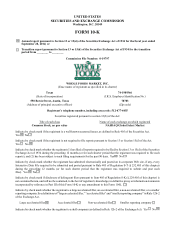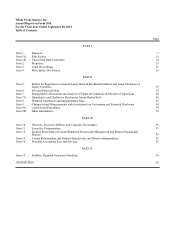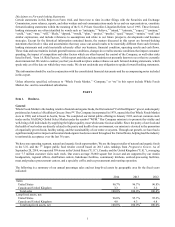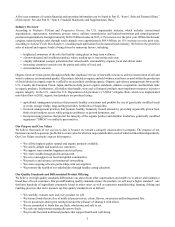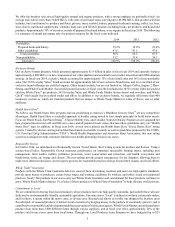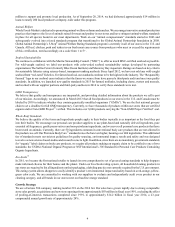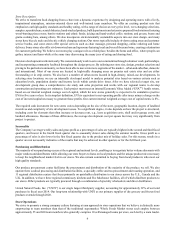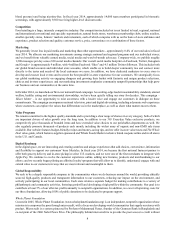Whole Foods 2014 Annual Report Download - page 4
Download and view the complete annual report
Please find page 4 of the 2014 Whole Foods annual report below. You can navigate through the pages in the report by either clicking on the pages listed below, or by using the keyword search tool below to find specific information within the annual report.
1
Disclaimer on Forward-looking Statements
Certain statements in this Report on Form 10-K and from time to time in other filings with the Securities and Exchange
Commission, news releases, reports, and other written and oral communications made by us and our representatives, constitute
forward-looking statements within the meaning of the U.S. Private Securities Litigation Reform Act of 1995. These forward-
looking statements are often identified by words such as “anticipate,” “believe,” “intend,” “estimate,” “expect,” “continue,”
“could,” “can,” “may,” “will,” “likely,” “depend,” “would,” “plan,” “project,” “predict,” “goal,” “target,” “sustain,” “seek” and
similar expressions, and include references to assumptions and relate to our future prospects, developments and business
strategies. Except for the historical information contained herein, the matters discussed in this report are forward-looking
statements that involve risks and uncertainties that may cause our actual results to be materially different from such forward-
looking statements and could materially adversely affect our business, financial condition, operating results and cash flows.
These risks and uncertainties include general business conditions, changes in overall economic conditions that impact consumer
spending, the impact of competition and other factors which are often beyond the control of the Company, as well other risks
listed in Part I, “Item 1A. Risk Factors,” of this report and risks and uncertainties not presently known to us or that we currently
deem immaterial. We wish to caution you that you should not place undue reliance on such forward-looking statements, which
speak only as of the date on which they were made. We do not undertake any obligation to update forward-looking statements.
This information should be read in conjunction with the consolidated financial statements and the accompanying notes included
in this report.
Unless otherwise specified, references to “Whole Foods Market,” “Company,” or “we” in this report include Whole Foods
Market, Inc. and its consolidated subsidiaries.
PART I
Item 1. Business.
General
Whole Foods Market is the leading retailer of natural and organic foods, the first national “Certified Organic” grocer, and uniquely
positioned as America’s Healthiest Grocery Store™. The Company incorporated in 1978, opened the first Whole Foods Market
store in 1980, and is based in Austin, Texas. We completed our initial public offering in January 1992, and our common stock
trades on the NASDAQ Global Select Market under the symbol “WFM.” Our Company mission is to promote the vitality and
well-being of all individuals by supplying the highest quality, most wholesome foods available. Since the purity of our food and
the health of our bodies are directly related to the purity and health of our environment, our mission is devoted to the promotion
of organically grown foods, healthy eating, and the sustainability of our entire ecosystem. Through our growth, we have had a
significant and positive impact on the natural and organic foods movement throughout the United States, helping lead the industry
to nationwide acceptance over the last 36 years.
We have one operating segment, natural and organic foods supermarkets. We are the largest retailer of natural and organic foods
in the U.S. and the 7th largest public food retailer overall based on 2013 sales rankings from Progressive Grocer. As of
September 28, 2014, we operated 399 stores in the United States (“U.S.”), Canada, and the United Kingdom (“U.K.”), averaging
over 7.7 million customer visits each week. Our stores average 38,000 square feet in size and are supported by our Austin
headquarters, regional offices, distribution centers, bakehouse facilities, commissary kitchens, seafood-processing facilities,
meat and produce procurement centers, and a specialty coffee and tea procurement and roasting operation.
The following is a summary of our annual percentage sales and net long-lived assets by geographic area for the fiscal years
indicated:
2014 2013 2012
Sales:
United States 96.7% 96.7% 96.8%
Canada and United Kingdom 3.3 3.3 3.2
Total sales 100.0% 100.0% 100.0%
Long-lived assets, net:
United States 96.0% 95.7% 95.2%
Canada and United Kingdom 4.0 4.3 4.8
Total long-lived assets, net 100.0% 100.0% 100.0%

